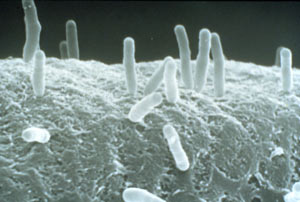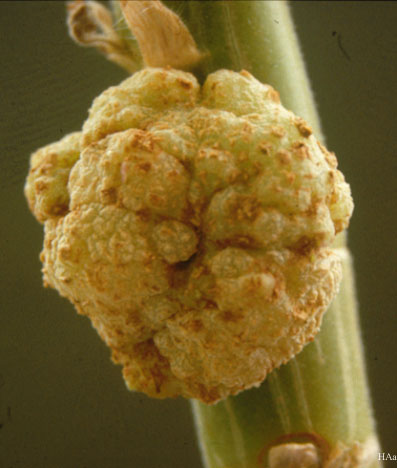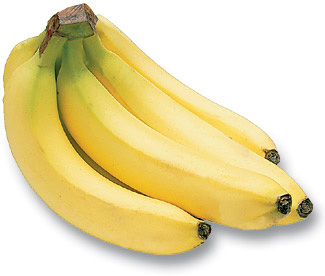Agrobacterium: Difference between revisions
No edit summary |
No edit summary |
||
| (5 intermediate revisions by 2 users not shown) | |||
| Line 1: | Line 1: | ||
{ | {{Curated}} | ||
{{Biorealm Genus}} | |||
[[Image:Agro1.JPG|frame|''Agrobacterium'' ''tumefaciens'' cells attached to a plant cell. From [http://www.genomenewsnetwork.org/articles/12_01/A_tumefaciens_genome.shtml Genome News Network and Martha Hawes].]] | [[Image:Agro1.JPG|frame|''Agrobacterium'' ''tumefaciens'' cells attached to a plant cell. From [http://www.genomenewsnetwork.org/articles/12_01/A_tumefaciens_genome.shtml Genome News Network and Martha Hawes].]] | ||
| Line 9: | Line 8: | ||
| width="802" height="874" bgcolor="#ffffff" valign="top" | | | width="802" height="874" bgcolor="#ffffff" valign="top" | | ||
<h2>Classification</h2><br style="clear:both" /><h3>'''Higher order taxa:'''</h3> Bacteria; Proteobacteria; Alphaproteobacteria; Rhizobiales; Rhizobiaceae; Rhizobium/Agrobacterium group <br /><h3>'''Species: '''</h3>''Agrobacterium agile, Agrobacterium albertimagni, Agrobacterium aurantiacum, Agrobacterium larrymoorei, Agrobacterium radiobacter, Agrobacterium rhizogenes, Agrobacterium rubi, Agrobacterium tumefaciens, Agrobacterium vitis, Agrobacterium ''sp. | <h2>Classification</h2><br style="clear:both" /><h3>'''Higher order taxa:'''</h3> Bacteria; Proteobacteria; Alphaproteobacteria; Rhizobiales; Rhizobiaceae; Rhizobium/Agrobacterium group <br /><h3>'''Species: '''</h3>''Agrobacterium agile, Agrobacterium albertimagni, Agrobacterium aurantiacum, Agrobacterium larrymoorei, Agrobacterium radiobacter, Agrobacterium rhizogenes, Agrobacterium rubi, Agrobacterium tumefaciens, Agrobacterium vitis, Agrobacterium ''sp. | ||
{| | |||
| height="10" bgcolor="#FFDF95" | | |||
'''NCBI: [http://www.ncbi.nlm.nih.gov/Taxonomy/Browser/wwwtax.cgi?id=357 Taxonomy] [http://www.ncbi.nlm.nih.gov/entrez/query.fcgi?db=genomeprj&cmd=Search&dopt=DocSum&term=txid357%5BOrganism:exp%5D Genomes] | |||
|} | |||
<h2>Description and Significance<br /></h2>At the turn of the century ''Agrobacterium tumefaciens'' was identified as the causal agent in crown gall disease in dicotyledonous plants. Since then, thorough research has been done on this bacterium's mechanism of tumor induction; in addition, ''Argorbacterium'' is used in numerous research projects as a means with which to introduce new genes into the genomes of a number of plants. | <h2>Description and Significance<br /></h2>At the turn of the century ''Agrobacterium tumefaciens'' was identified as the causal agent in crown gall disease in dicotyledonous plants. Since then, thorough research has been done on this bacterium's mechanism of tumor induction; in addition, ''Argorbacterium'' is used in numerous research projects as a means with which to introduce new genes into the genomes of a number of plants. | ||
| Line 26: | Line 30: | ||
''Agrobacterium'' ''tumefaciens'' is most widely known for causing crown gall disease that affects many dicotyledonous (broad-leaved) plants; another strain called biovar 3 causes crown gall disease in grapvines. The disease causes the formation of tumor-like swellings called galls that can generally be found on the crown of the plant just above the soil. Crown gall disease does not usually seriously harm older plants; however, it may reduce the value of a plant in a nursery. | ''Agrobacterium'' ''tumefaciens'' is most widely known for causing crown gall disease that affects many dicotyledonous (broad-leaved) plants; another strain called biovar 3 causes crown gall disease in grapvines. The disease causes the formation of tumor-like swellings called galls that can generally be found on the crown of the plant just above the soil. Crown gall disease does not usually seriously harm older plants; however, it may reduce the value of a plant in a nursery. | ||
[[Image:gall.jpg|frame|left|Courtesy of [http://biologi.uio.no/plfys/haa/gen/gmo.htm Halvor Aarnes | |||
A gall caused by ''Agrobacterium'' ''tumefaciens.'']] | |||
''Agrobacterium'' ''tumefaciens'' causes crown gall disease by first transferring part of its DNA into an opening in the plant. The DNA is attches itself to the plants DNA through histones. The DNA then integrates itself into the plant's genome and causes the formation of the gall. Because of how smoothly ''Agrobacterium tumefaciens'' is able to transfer DNA it has become a helpful tool for scientists to use. | ''Agrobacterium'' ''tumefaciens'' causes crown gall disease by first transferring part of its DNA into an opening in the plant. The DNA is attches itself to the plants DNA through histones. The DNA then integrates itself into the plant's genome and causes the formation of the gall. Because of how smoothly ''Agrobacterium tumefaciens'' is able to transfer DNA it has become a helpful tool for scientists to use. | ||
<h2>Banana Vaccines </h2> | <h2>Banana Vaccines </h2> | ||
Bananas have potential to become the world's first edible vaccine due to ''Agrobacterium''. An edible vaccine doesn't need sterile syringes, costly refrigeration, or multiple injections. According to the World Health Organization (WHO), more than 2 million children die worldwide each year from diarrhea that can be prevented easily with vaccines. | |||
[[Image:bananas.JPG|frame|left|From [http://www.wegmans.com/kitchen/ingredients/produce/fruit/bananas.asp Wegmans Bananas]]] Thus, researchers lead by Dr. Charles Arntzen are looking into making the food vaccines to prevent diarrhea caused by ''Escherichia coli'' and ''Vibrio cholara'' bacteria. First, the gene for an immune system-stimulating disease protein would have to be spliced into the bacterium. The bacterium is then allowed to contaminate banana cells, inserting the Ti plasmid (containing the spliced gene) into their chromosomes. The next step is to grow the cells until they are mature fruit-bearing plants. The fruits, when eaten, would transfer the immunity to a particular disease into the consumer's body. This would be a relatively inexpensive and feasible method to distribute certain vaccines to people, especially in developing countries. | |||
Bananas have potential to become the world's first edible vaccine due to ''Agrobacterium''. An edible vaccine doesn't need sterile syringes, costly refrigeration, or multiple injections. According to the World Health Organization (WHO), more than 2 million children die worldwide each year from diarrhea that can be prevented easily with vaccines. Thus, researchers lead by Dr. Charles Arntzen are looking into making the food vaccines to prevent diarrhea caused by ''Escherichia coli'' and ''Vibrio cholara'' bacteria. First, the gene for an immune system-stimulating disease protein would have to be spliced into the bacterium. The bacterium is then allowed to contaminate banana cells, inserting the Ti plasmid (containing the spliced gene) into their chromosomes. The next step is to grow the cells until they are mature fruit-bearing plants. The fruits, when eaten, would transfer the immunity to a particular disease into the consumer's body. This would be a relatively inexpensive and feasible method to distribute certain vaccines to people, especially in developing countries. | |||
This has already been shown to work using potatoes and a modified'' E. coli'' protein that is known to cause severe diarrhea. When mice ate the raw engineered potatoes, they developed the antibodies to the ''E. coli ''toxin. Clinical tests on humans eating genetically engineered potatoes also showed that they started producing antibodies against Norwalk virus, which causes acute bouts of diarrhea (Redig 2003). For now, all clinical trials involve genetically modified potatoes or tomatoes, both of which can easily be freeze-dried, transported, and reconstituted. These can be more easily dosage regulated and quality controlled, unlike a banana tree growing in the middle of a village, for example. But the ideal of fresh banana vaccines is still being developed and perfected. | This has already been shown to work using potatoes and a modified'' E. coli'' protein that is known to cause severe diarrhea. When mice ate the raw engineered potatoes, they developed the antibodies to the ''E. coli ''toxin. Clinical tests on humans eating genetically engineered potatoes also showed that they started producing antibodies against Norwalk virus, which causes acute bouts of diarrhea (Redig 2003). For now, all clinical trials involve genetically modified potatoes or tomatoes, both of which can easily be freeze-dried, transported, and reconstituted. These can be more easily dosage regulated and quality controlled, unlike a banana tree growing in the middle of a village, for example. But the ideal of fresh banana vaccines is still being developed and perfected. | ||
<h2>References | <h2>References</h2> | ||
[http://www.wegmans.com/kitchen/ingredients/produce/fruit/bananas.asp Brown, Kathryn. 1996. "Vaccine Cuisine." Environmental Health Perspectives, vol. 104, no. 3. ] | [http://www.wegmans.com/kitchen/ingredients/produce/fruit/bananas.asp Brown, Kathryn. 1996. "Vaccine Cuisine." Environmental Health Perspectives, vol. 104, no. 3. ] | ||
Latest revision as of 21:40, 23 July 2010
A Microbial Biorealm page on the genus Agrobacterium

ClassificationHigher order taxa:Bacteria; Proteobacteria; Alphaproteobacteria; Rhizobiales; Rhizobiaceae; Rhizobium/Agrobacterium groupSpecies:Agrobacterium agile, Agrobacterium albertimagni, Agrobacterium aurantiacum, Agrobacterium larrymoorei, Agrobacterium radiobacter, Agrobacterium rhizogenes, Agrobacterium rubi, Agrobacterium tumefaciens, Agrobacterium vitis, Agrobacterium sp.Description and SignificanceAt the turn of the century Agrobacterium tumefaciens was identified as the causal agent in crown gall disease in dicotyledonous plants. Since then, thorough research has been done on this bacterium's mechanism of tumor induction; in addition, Argorbacterium is used in numerous research projects as a means with which to introduce new genes into the genomes of a number of plants.
Genome StructureAgrobacterium tumefaciens str. C58 has an unusual chromosomal organization - it has a 2 Mb linear and a 2.8 Mb circular chromosome as well as a 206.479 kbp Ti (tumor-inducing) plasmid. The genes that cause gall formation in plants are located for the most part on the the Ti plasmid. Interestingly, if Agrobacterium is grown near its maximum temperature of about 30oC, then the plasmid is lost as well as the pathogenicity of the bacterium. The bacterium itself is still functional and can thrive in culture (Deacon). The genome of Agrobacterium vitis is currnetly being sequenced. It causes gall disease in grapes. Cell Structure and Metabolism
|


